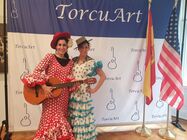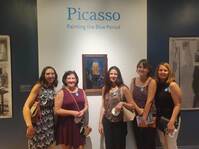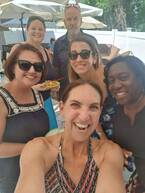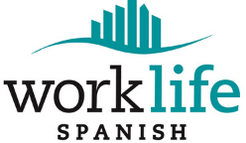|
Introduction: In today's fast-paced and competitive world, continuous learning and skill development are essential for personal and professional growth. At Work-Life Spanish, we understand the significance of acknowledging and showcasing the progress and accomplishments of our students. That's why we have implemented a comprehensive system that includes Level Exit Exams and Digital Badges, empowering our learners to celebrate their achievements and advance confidently in their Spanish language journey. Understanding the ABC Approach: Work-Life Spanish's unique ABC approach to Spanish language learning is based on the European Framework of Reference for Foreign Languages, dividing language proficiency into six levels: A1, A2, B1, B2, C1, C2. This structured approach ensures a systematic learning process that allows students to track their progress and continuously improve their language skills. The Journey to Success: Our Spanish language learning journey begins with a Level Placement Entrance Exam, which helps determine the starting level for each student. After customizing their study plan with a mix of 20-hour group courses, conversational club events, and private lessons, students embark on mastering each level by completing the relevant courses. The Importance of Level Exit Exams and Digital Badges: Upon successful completion of all courses within their starting level, students become eligible to take our Level Exit Exams. These exams play a crucial role in assessing students' language proficiency and validating their hard work and dedication. One of the main advantages of Level Exit Exams is their role in keeping group courses homogenous and ensuring students are on track with their language growth. Moreover, they serve as a motivational milestone, encouraging students to stay committed to their learning journey. The true celebration of success comes with the issuance of digital badges. These micro-credential badges are online representations of earned knowledge and skills, making it easy to validate and showcase learning achievements in both formal and informal contexts. Digital badges are a powerful tool for recognizing competencies beyond traditional academic degrees and provide a visible way to demonstrate a diverse skill set. The Impact of Digital Badges: Digital badges carry immense value in the professional world. They allow potential employers to quickly identify a candidate's acquired skills and the efforts put into continuous learning and self-improvement. As companies increasingly offer digital badges for completing certain programs, these certifications become essential for individuals looking to stand out in the job market. For Work-Life Spanish students, digital badges open doors to higher-level courses and further opportunities for growth. Each badge represents a level of proficiency achieved and motivates learners to continue their pursuit of fluency in the Spanish language. Conclusion: The issuance of digital badges for students who complete Level Exit Exams at Work-Life Spanish is a crucial step in recognizing and celebrating their achievements. These badges not only represent language proficiency but also serve as a powerful testament to continuous learning and dedication. As the importance of digital credentials continues to grow in the modern job market, our students are well-equipped to showcase their competencies and seize exciting opportunities for personal and professional development. So, if you're ready to embark on a rewarding Spanish language learning journey and celebrate your success with digital badges, join Work-Life Spanish's ABC approach today and watch your language skills soar! Artesanias Castor Ayala
Loiza, Puerto Rico 22 July 2023
0 Comments
 Washington, D.C. is a vibrant city known for its rich cultural diversity. Among the numerous communities that contribute to the city's multicultural fabric, the Spanish-speaking population holds a prominent place. Whether you're a Spanish language enthusiast, a culture aficionado, or simply looking to immerse yourself in a different experience, Washington, D.C. offers a plethora of opportunities to explore and enjoy Spanish language and culture. Check out our top 5 ways to get involved with Spanish culture right here in D.C.!  1. WATCH A PLAY AT EL TEATRO GALA For theater enthusiasts looking to experience the magic of Spanish-language performances, a visit to El Teatro Gala is a must. Located in the heart of Washington, D.C., this theater is dedicated to showcasing Hispanic and Latin American plays, bringing the richness and diversity of Spanish-speaking cultures to the stage. From contemporary works to classic masterpieces, El Teatro Gala offers a range of thought-provoking and entertaining productions that captivate audiences. Immerse yourself in the world of Spanish-language theater and witness the talent of actors, directors, and playwrights as they bring stories to life in a truly captivating manner.  2. ATTEND CULTURAL EVENTS AND FESTIVALS Washington, D.C. hosts numerous cultural events and festivals celebrating the vibrant Spanish-speaking communities. TorcuArt's Flamenco Festival, the Latino Heritage Festival, Fiesta DC, and the Smithsonian Folklife Festival are just a few examples of the exciting celebrations where you can immerse yourself in the sounds, tastes, and traditions of different Spanish-speaking countries. From lively music and dance performances to delicious cuisine and artisanal crafts, these events offer a fantastic opportunity to engage with Spanish culture and connect with the local community.  3. VISIT LOCAL MUSEUMS TO VIEW SPANISH EXHIBITIONS Washington, D.C. is home to several world-class museums that regularly feature exhibitions on Spanish artists. The National Gallery of Art , the Phillips Collection, among many others, often host exhibitions dedicated to Spanish masters such as Francisco de Goya, Diego Velázquez, and Pablo Picasso. Explore their masterpieces, learn about their artistic techniques, and gain a deeper understanding of the historical and cultural contexts in which they created their iconic works.  4. CLIMB THE SPANISH STEPS Located in the historic neighborhood of Kalorama, the Spanish Steps (Escalinata) are a must-visit destination for any lover of Spanish culture. Inspired by the famous Spanish Steps in Rome, this charming staircase adorned with intricate tile work and a beautiful fountain serves as a gathering place for locals and tourists alike. Take a leisurely stroll through this picturesque spot, soak in the vibrant atmosphere, and perhaps practice your Spanish with fellow visitors.  5. JOIN A SPANISH LANGUAGE MEETUP If you're eager to practice your Spanish language skills, join the Work-Life Spanish Meetup group! Events cater to Spanish learners and native speakers alike and provide a friendly and supportive environment where you can engage in conversations, improve your fluency, and engage in cultural experiences around the DC metro area. Washington, D.C. is not only the political hub of the United States but also a melting pot of cultures, including a vibrant Spanish-speaking community. Signing up for Spanish language classes at Work-Life Spanish will not only help you learn another language, but will open your eyes to the richness of the Spanish language and culture both abroad and here in the nation's capital. |
AuthorTara Pérez ArchivesCategories |
|
© 2022 | Work-Life Spanish, LLC All Rights Reserved |


 RSS Feed
RSS Feed